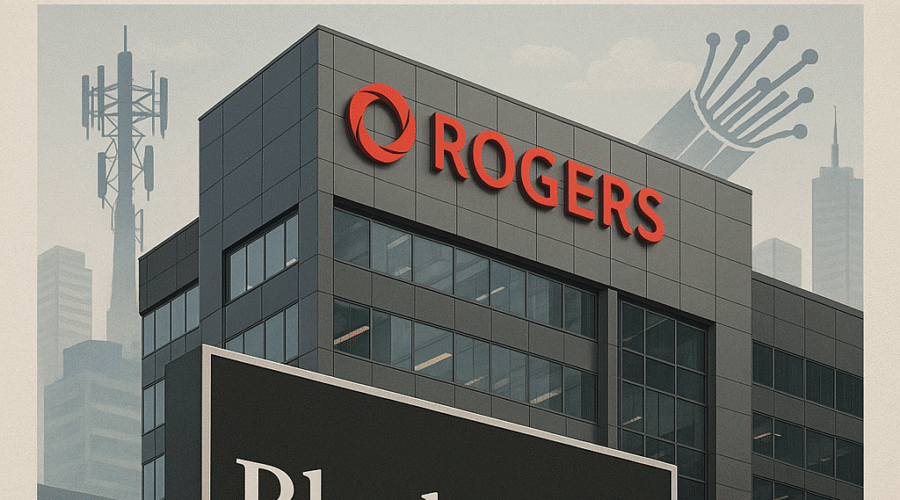In a landmark transaction reshaping telecom infrastructure financing, Rogers Communications has finalized a CDN$7 billion ($5.1 billion) equity partnership with a Blackstone-led consortium including Canada’s largest institutional investors. This innovative deal monetizes Rogers’ wireless backhaul transport infrastructure while retaining operational control, reducing leverage by 0.7x immediately and providing capital flexibility for 5G expansion. The transaction exemplifies how telecom operators can unlock hidden asset value while maintaining strategic network sovereignty[2][3][5][6][9][10][11][14][15].
💼 Seasoned CorpDev / M&A / PE expertise
Transaction Architecture and Control Mechanisms
Structural Engineering for Balance Sheet Optimization
The investment targets a newly formed Canadian subsidiary holding passive wireless backhaul infrastructure—the critical fiber-optic network connecting cell towers to core networks. Blackstone secured a 49.9% equity position with capped 20% voting rights, while Rogers retains 50.1% ownership and 80% voting control. This deliberate asymmetry ensures Rogers maintains absolute operational command over network upgrades, service quality decisions, and technology roadmaps[3][6][15]. The subsidiary’s financials will be consolidated within Rogers’ statements, satisfying rating agency requirements for equity treatment rather than debt classification[15][18].
Capital Flow Mechanics and Repurchase Framework
The subsidiary will distribute approximately CDN$400 million annually to Blackstone during the first five years, creating predictable cash flows for investors. Crucially, Rogers secured a repurchase window between years 8-12 at a fixed 7% annual capital cost—a strategic hedge against future interest rate volatility. This structure provides Rogers with immediate debt reduction while preserving long-term asset recovery optionality[15][18]. The embedded repurchase mechanism functions as a call option on infrastructure appreciation, allowing Rogers to reclaim full ownership when strategically advantageous[8][18].
Investor Consortium Composition and Strategic Alignment
Blackstone’s Infrastructure Credit Platform
Blackstone Credit & Insurance (BXCI) deployed capital from its $90 billion infrastructure and asset-based credit platform, leveraging specialized expertise in telecom infrastructure. Robert Horn, Global Head of Infrastructure & Asset Based Credit, emphasized the transaction aligns with mobile data megatrends while providing “flexible and efficient capital solutions” for corporate partners. BXCI’s involvement signals institutional confidence in backhaul infrastructure as a distinct asset class with predictable long-term cash flows[9][11][14].
Canadian Institutional Participation
The investor syndicate represents a who’s-who of Canadian pension capital: Canada Pension Plan Investment Board (CPP Investments), Caisse de dépôt et placement du Québec (CDPQ), Public Sector Pension Investment Board (PSP Investments), British Columbia Investment Management Corporation (BCI), and Investment Management Corporation of Ontario (IMCO). This domestic alignment mitigates regulatory concerns while satisfying Canada’s strategic interest in retaining critical infrastructure ownership. The consortium’s participation validates the asset’s investment-grade characteristics and long-term stability[2][6][9][10][14].
Financial Engineering and Balance Sheet Impact
Leverage Reduction and Credit Metric Improvement
The CDN$7 billion infusion enables Rogers to reduce debt-to-EBITDA leverage by 0.7x immediately, contributing to a cumulative 1.0x reduction since late 2024. CFO Glenn Brandt confirmed the transaction “strengthens our investment grade balance sheet” by unlocking unrecognized asset value without shareholder dilution. This deleveraging is critical for Rogers’ $26 billion Shaw acquisition integration and upcoming 5G spectrum auctions[6][8][15][18]. Rating agencies Moody’s, S&P, and DBRS have pre-validated the equity treatment, avoiding negative credit implications despite the substantial capital inflow[15].
Comparative Infrastructure Monetization Models
Unlike tower sale-leasebacks that create permanent operational dependencies, Rogers’ structure represents a hybrid monetization model. The transaction shares characteristics with: (1) Cell tower REITs through income distribution mechanisms, (2) Infrastructure funds’ capital recycling strategies, and (3) Private equity’s structured equity investments. This synthesis creates a new template for telecom operators seeking temporary capital relief without permanent asset separation[3][8][18][19].
Strategic Rationale and Industry Implications
Rogers’ 5G Expansion Imperative
The capital infusion arrives as Rogers accelerates DOCSIS 4.0 deployment and fiber-to-the-home (FTTH) expansion. Recent network tests with Comcast’s XB10 gateway demonstrate Rogers’ path toward symmetrical multi-gigabit speeds, requiring substantial backhaul capacity upgrades. CEO Tony Staffieri emphasized the partnership “demonstrates confidence in our world-class assets” amid Canada’s intensifying broadband competition[4][10][19]. The transaction funds critical infrastructure enhancements without increasing debt covenants during a period of significant technological transition.
Broader Telecom Infrastructure Investment Trend
This transaction exemplifies the accelerating institutional appetite for telecom infrastructure assets. Similar deals include: DigitalBridge’s $11 billion acquisition of Zayo Group (2019), KKR’s $12 billion investment in Telecom Italia’s network (2021), and BlackRock’s $10 billion Global Infrastructure Partners acquisition (2024). The Rogers-Blackstone deal distinguishes itself through its innovative equity structure and domestic pension fund alignment—features likely replicated in upcoming Canadian telecom transactions[1][13][18].
Risk Analysis and Structural Safeguards
Regulatory and Operational Protections
The transaction includes multiple safeguards: (1) Explicit prohibition on foreign control through voting right limitations, (2) Canadian institutional investor majority participation, (3) Rogers’ retained control over all network operations, and (4) CRTC compliance certifications. These measures preemptively address national security concerns while ensuring uninterrupted network governance[3][6][10][15].
Distribution Sustainability Analysis
The CDN$400 million annual distribution represents approximately 5.7% yield on invested capital—a sustainable level given backhaul infrastructure’s recession-resistant cash flows. Stress testing indicates distributions remain viable even under 20% revenue decline scenarios due to the essential nature of wireless backhaul. The five-year distribution period aligns with Rogers’ 5G rollout timeline, creating natural alignment between investor returns and network enhancement cycles[15][18][19].
Conclusion: Blueprint for Telecom Infrastructure Finance
The Rogers-Blackstone partnership establishes a replicable model for telecom operators globally: monetizing passive infrastructure while retaining strategic control. For Rogers, the transaction delivers immediate balance sheet relief and funds technological transformation. For Blackstone and Canadian pensions, it provides exposure to essential digital infrastructure with predictable returns. This hybrid approach—blending private equity capital with pension fund stability—may become the dominant template for next-generation telecom financing as operators balance network investment with fiscal responsibility[8][10][15][18]. The embedded repurchase option particularly demonstrates sophisticated financial engineering, granting Rogers future flexibility while satisfying current capital needs. As data consumption grows exponentially, such innovative partnerships will prove critical for bridging the $1.7 trillion global infrastructure investment gap identified by the World Bank.
Sources





